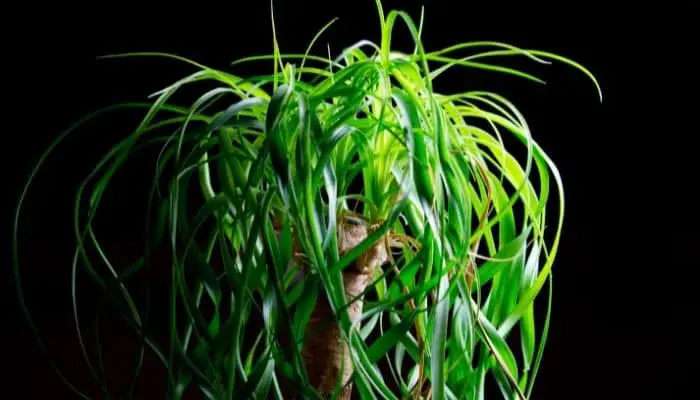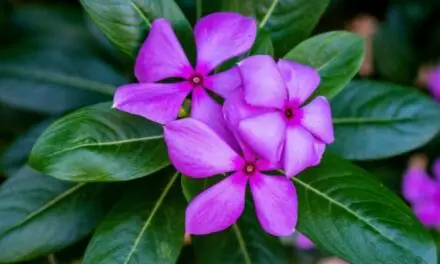If you’ve got a Ponytail Palm, you’ll be familiar with those lush, delicate leaves that spring out from the stem in a rush of green.
Ponytail Palms are stunning and they are becoming increasingly popular houseplants, but sometimes, their color seems to change from rich green to purple.
Table of Contents
Why Is My Ponytail Palm Turning Purple?

Your Ponytail Palm is turning purple because it is stressed from receiving too much direct sunlight.
That doesn’t mean the leaves are burning, however.
Some people call it the plant’s equivalent of a suntan!
Don’t panic, but keep an eye on your plant and look for signs that it’s unhappy so you can take action if necessary.
Often, a change in color is a sign that a plant is stressed.
If your Ponytail Palm has just been re-homed (either bought from a nursery or store or moved from one part of your house to another), you should watch for color changes.
It seems likely that the purple coloration is a result of excessive sunlight, but your plant isn’t necessarily burning, and may not show signs of leaf damage.
Ponytail Palms often turn purple when they are planted outside in full sun without first acclimatizing it to direct sunlight.
However, as time progresses, if it doesn’t acclimatize to the excess light or if the summer sun is just too strong, it may start to burn.
Something similar often happens with succulents.
Interestingly, many succulents also produce red or dark purple coloration as a response to too much sunlight; your Ponytail Palm may be doing the same thing.
A succulent produces carotenoid and anthocyanin, pigments that help to protect it from the damage the sun may cause.
It is the anthocyanin that is responsible for purple coloration (while carotenoid usually results in yellow or red).
This color can help to protect your plant from damage as a result of the sun’s rays, but it is also a sign that it’s getting more sun than it likes.
You don’t need to take immediate action, but do keep an eye on your plant, and step in if things get worse.
You don’t want it burning to a crisp!
Also Read: Why Is My Ponytail Palm Not Flowering? (It Probably Won’t)
How To Get Your Ponytail Palm Back To A Healthy Green Color?
If you don’t like your Ponytail Palm’s darker color, you should be able to restore its vivid green, but it may take some time.
First, you’ll need to reduce the amount of direct sun it’s getting from day to day.
If Your Ponytail Palm Is Potted
If your plant is in a pot, this may be easy; you can shift it to another location, or even just set up a shade or move it a few inches back from the windowsill.
If Your Ponytail Palm Is Planted In Your Garden
However, if your plant is in the ground, this could be much trickier.
Unless you wish to dig it out, your options will be limited – but there are still a couple of things you can try.
Set Up A Temporary Shade
Start by rigging up a temporary shade that shields it from the hottest part of the sun.
This doesn’t need to block the sun out completely but should reduce the glare so that the plant’s leaves are not under such intense light.
This shade will also help you determine whether blocking the light is effective and how much you need to block.
Remember, it will take a good while for the plant to turn back to green; it may need to grow entirely new leaves that don’t contain the red pigment.
However, if you’re determined, this is the first step to take.
Plant Something Larger Beside Your Ponytail Palm
Secondly, consider planting something else that will provide this shade on a more permanent basis.
For example, a tall bush may be enough to filter some of the sunlight and stop your palm from taking so much full sun every day.
If the space is suitable, you could also consider a trellis and climbing plants to block some of the light.
Make Something To Create Shade
A man-made structure may also do the trick.
What works best will depend on your setup, the angle the light is coming from, and how much direct light you need to block.
You might find it’s easier to just relocate the plant!
How To Stop Your Ponytail Palm From Turning Purple
To stop your Ponytail Palm from turning purple you’ll need to keep it out of direct afternoon sunlight.
Being native to the semi-desert regions of South America, this plant can handle its fair share of full sun.
The problem arises when the sunlight is just too intense or when your plant has been used to lower light levels and you suddenly move it into full sun without acclimatizing it first.
This plant needs lots of bright light, but the brightness doesn’t need to come from direct sunlight.
You can keep it at the sunniest window you have, just put up a sheer curtain so that the sunlight hitting your ponytail palm has been filtered.
You can also expose it to some less intense morning sunlight.
This way, your palm will receive all the bright light it loves without needing to turn purple.
Final Thoughts
Your Ponytail Palm may go purple if it’s stressed – usually by getting too much sun.
Try to think about this when positioning the palm, and don’t put it in a spot that gets full sun all day long.
A bit of shade will help the plant maintain its luscious green foliage.




